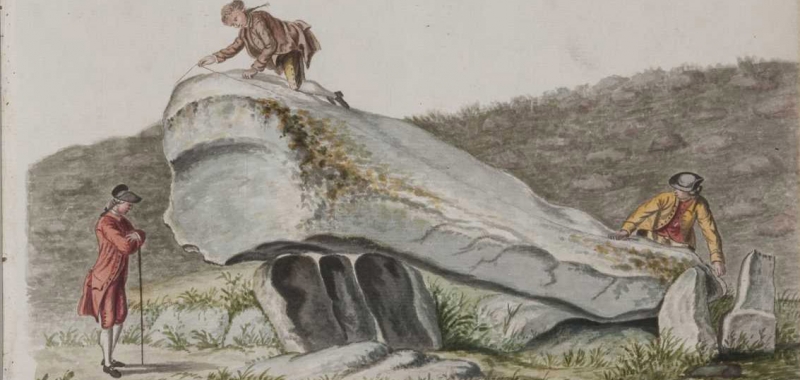Gabriel Beranger, c.1729–1817
Gabriel Beranger, c.1729–1817, was born into a Huguenot family in the Netherlands. He came to Ireland circa 1750 and remained there for the rest of his life. He ran a print shop and artist’s warehouse in Dublin’s South George’s Street for more than a decade after 1766. During the 1760s and 1770s he painted watercolours of scenes in the Dublin region. He also went on expeditions to many other parts of Ireland, sometimes accompanied by fellow artists. Places he visited to sketch landscapes or antiquarian buildings included Wicklow, Wexford, Navan, Dundalk, Glendalough, and Moira, County Down. He went on an extended expedition to Connacht and Ulster in 1779, accompanied by an Italian artist, Angelo Bigari.
William Burton Conyngham and Charles Vallancey were among his patrons. In the years 1779 to 1783 Beranger was employed by Burton Conyngham to illustrate Irish antiquities on behalf of the newly founded Hibernian Antiquarian Society. This was the context of Beranger’s journey through Connacht with Bigari in 1779. The artists were tasked with recording antiquities in the landscape, in what Peter Harbison has described as ‘the most extensive archaeological survey undertaken in Ireland before the Ordnance Survey’ (Harbison, 2002, 1). They made contact with local scholars such as Charles O’Conor of Ballinagare. The Hibernian Antiquarian Society grand scheme to publish the visual record of antiquities that they produced was never implemented. A few engravings of Beranger’s drawings were published anonymously in Colonel Vallancey’s serial publication, Collectanea de rebus Hibernicis (Dublin, 1786–1807).
Despite his industriousness, it appears to have been difficult for Beranger to make a living exclusively as an artist in Dublin, even with his second wife’s wealth and the occasional patronage of William Burton Conyngham and Charles Vallancey. To supplement his income in later life he took a government job in 1783 as an assistant ledger-keeper in the exchequer office, remaining there for six years.
Beranger compiled manuscript journals of his artistic expeditions, describing the places he went, people he met and sometimes noting the condition of the antiquarian monuments visited. These manuscript notes do not appear to survive, but Sir William Wilde had access to them and quoted extensively from them in a memoir of Beranger that he published in 1870. Wilde’s work on Beranger was completed and reissued by his wife, Speranza, in 1880.
Royal Irish Academy MS 3 C 30 is an album of Beranger’s watercolours and digitally preserved online by the Digital Repository of Ireland (DRI). Another similar album is held in the National Library of Ireland, MS 1958 TX. Beranger makes clear that the watercolours in the albums included copies of works by other artists. Selections from these two albums have been edited for publication by Peter Harbison. Two smaller albums entitled ‘Rambles through the county of Dublin ...’ are in RIA, MSS 3 C 31 and 3 C 32, and these are also online at the DRI. In addition to Dublin scenes, these post-card sized albums of Beranger’s own work include some illustrations of scenery and monuments from Mayo, Meath and Wicklow. All these drawings are also available at the Watercolour World website - a database of pre-1900 documentary watercolours from private and public collections around the world.
In addition to his own original works, Beranger also made copies of works by other artists. Such albums of antiquities, depicting picturesque ruined castles and friaries, would have been popular additions to the libraries of the gentry in the late eighteenth century. In his drawings of antiquarian buildings, and in copies of the work of others, he sometimes depicted human figures, viewed from the back. These human figures, sometimes intended as depictions of the artist himself, were useful in conveying a sense of scale.
Beranger’s Irish antiquarian drawings record many buildings that no longer survive, while others have been restored since the mid nineteenth century. His sketches are a record of the appearance and condition of those antiquities as they existed in the second half of the eighteenth century.
Further reading
Peter Harbison, Beranger’s views of Ireland (Dublin, 1991)
Peter Harbison, Beranger’s antique buildings of Ireland (Dublin, 1998)
Peter Harbison, ‘Our treasure of antiquities’: Beranger and Bigari’s antiquarian sketching tour of Connacht in 1779 (Bray, 2002)
Peter Harbison (ed.), Beranger’s Rambles in Ireland, based on the Royal Irish Academy manuscripts, 3 C 31, 32, and 30 (Bray, 2004)
Peter Harbison, ‘Beranger, Gabriel (d.1817)’, in Dictionary of Irish biography (9 vols, Cambridge, 2009), i, pp 461–2 (dib.cambridge.org)
Peter Harbison, William Burton Conyngham and his Irish circle of antiquarian artists (New Haven, 2012)
Niamh NicGhabhann, ‘Beranger, Gabriel’, in Nicola Figgis (ed.), Art and Architecture of Ireland, volume II: Painting, 1600–1900 (New Haven: Yale University Press for the Royal Irish Academy and the Paul Mellon Centre, 2014), pp 176–7
William Wilde, A memoir of Gabriel Beranger and his labours in the cause of Irish art and antiquities from 1760 to 1780 (Dublin, 1880)
Royal Irish Academy online catalogue of Prints and Drawings
AC
April 2023

